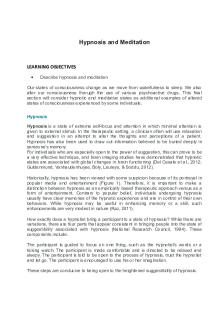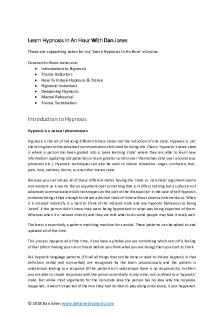11. Hypnosis PDF

| Title | 11. Hypnosis |
|---|---|
| Author | NB KR |
| Course | Introductory Psychology I |
| Institution | University of New England (Australia) |
| Pages | 3 |
| File Size | 59.8 KB |
| File Type | |
| Total Downloads | 98 |
| Total Views | 148 |
Summary
Hypnosis...
Description
Study Notes – Hypnosis
Mesmer & Animal Magnetism -
Mesmer witnessed some of Father Gassner’s exorcisms and faith healing (Munich) Naturalistic account Messer proposed: Hydraulic/Fluid metaphor and field theories common in 18th century science &… Human body contains 2 magnet-like poles Magnetic fluid is evenly distributed between them Disease is due to an imbalance in the field
(we now know this theory is false) Mesmerism and Public Health -
The balance of this substance is under the control of human will Mesmer’s therapeutic procedures designed to manipulate the balance and return the substance and to a state of equilibrium Aim was low cost public health (social medicine) Opposed by vested medical interests in Paris
Franklin Royal Commission -
Royal Commission led by Benjamin Franklin investigated Mesmer’s claims It was concluded that imagination was responsible for the phenomena found by Mesmer No evidence found to support the existence of an animal magnetic fluid Social and cognitive influences were responsible for the “magnetism” found by Mesmer Mesmer observed that patients needed to be willing participants in the therapeutic process in order for them to benefit
Medical Applications -
Hypnotic Analgesia Unavailability or unsuitability of chemical analgesia Childbirth, emergencies, dentistry, surgery, distress due to medical procedures (changing burn dressings, chemotherapy Reduced bleeding during surgery, fewer complications, faster recovery Not mediated by distraction of attention Not reversed by Naloxone (opioid antagonist)
Cognitive Behavioural Applications -
Stress management – relaxation training
-
Symptom/behaviour management (smoking cessation, weight loss) Imaginal exposure (phobias, PTSD – also emotional numbing) Cognitive restructuring (virtual reality) – (age progression, body image)
Hypnotic Analgesia Both hypnotic ability and hypnotic suggestion are important for hypnotic analgesia. Assignment involved use of hypnosis to treat pain. Individual Differences in Hypnotic Susceptibility -
Not all individuals are able to respond to hypnotic suggestions Individual differences in response were a key finding of the Franklin Commission Characteristics of the hypnotized person must be important This fact must be considered by any adequate practice of hypnosis
Objective Measurement of Hypnotic Susceptibility -
Standardised induction, individual suggestions and de-induction procedures Suggestions presented one by one tapping range of historical content areas Objectively defined behavioural criteria for passing each suggestion Hypnotic susceptibility is the total number of suggestions passed If you are susceptible, this stays the same throughout age
Hypnotic Suggestions -
Ideomotor – suggested (no volitional) movement e.g. arm levitation Challenge: Suggested difficulty in movement then challenged to respond Cognitive delusory: positive or negative: Age regression Post hypnotic amnesia Hallucinations (e.g. hypnotic sex change) Non-existent numeral (#3 doesn’t exist) Post hypnotic compulsion (say February) Automatic writing
Hypnotically “Refreshed” Memory -
Apparent vivid recall of forgotten events in age regression (hypermnesia) But c.f age progression vivid hallucinatory response to suggestion People recall both truer and more false details under hypnosis (lower response criterion) They are more confident in memories recalled under hypnosis High susceptibles may show pseudo memories – false beliefs in suggested events Sessions should be videotaped to detect leading questions Hypnotic memories cannot be accepted without independent corroboration
Absorption -
Absorption developed as a scale of hypnosis like experiences in everyday life Criterion was prediction of hypnotic susceptibility Independent of major personality traits Refers not to behaviour but trance like experience Positively associated with baroreflex sensitivity
Absorption & Biofeedback -
EMG Biofeedback Low Absorption S’s – less tense and more relaxed - Performance enhanced by biofeedback signal - Performance inhibited by self-generated imagery
-
High Absorption S’s – more tense when trying to do biofeedback - Performance enhanced by self-generated imagery - Performance inhibited by biofeedback signal
Why is Hypnosis Important for psychology? -
Psychobiology of self-regulation Expression of cultural and historical universal in human experience Hypnosis is safe and reliable and rapid means of producing trance states under laboratory conditions
Clinical Hypotheses -
Psychopathology may be considered as a disruption in systems of self-regulatory control Hypnosis and absorption states permit forms of self-regulation that differ from active cognitive control Effective intervention strategies should consider: - The specific forms of dysregulation underlying particular symptoms - The match or mismatch between a client’s aptitude for specific forms of selfregulation and the mechanisms required by alternative interventions....
Similar Free PDFs

11. Hypnosis
- 3 Pages

Hypnosis Quiz - QUIZ
- 3 Pages

Tutorial Hypnosis
- 5 Pages

The Stage Hypnosis Guide (Autosaved)
- 56 Pages

Hypnosis and Meditation
- 3 Pages

Hypnosis a pseudoscience
- 2 Pages

4. Hypnosis - Lecture notes 4
- 18 Pages

11 - Lecture notes 11
- 14 Pages

11 - Capítulo 11 Guyton
- 10 Pages

11 LipogÉnesis - Apuntes 11
- 9 Pages

Tema 11 - Apuntes 11
- 8 Pages

11
- 24 Pages

Tema 11 - Apunts 11
- 6 Pages
Popular Institutions
- Tinajero National High School - Annex
- Politeknik Caltex Riau
- Yokohama City University
- SGT University
- University of Al-Qadisiyah
- Divine Word College of Vigan
- Techniek College Rotterdam
- Universidade de Santiago
- Universiti Teknologi MARA Cawangan Johor Kampus Pasir Gudang
- Poltekkes Kemenkes Yogyakarta
- Baguio City National High School
- Colegio san marcos
- preparatoria uno
- Centro de Bachillerato Tecnológico Industrial y de Servicios No. 107
- Dalian Maritime University
- Quang Trung Secondary School
- Colegio Tecnológico en Informática
- Corporación Regional de Educación Superior
- Grupo CEDVA
- Dar Al Uloom University
- Centro de Estudios Preuniversitarios de la Universidad Nacional de Ingeniería
- 上智大学
- Aakash International School, Nuna Majara
- San Felipe Neri Catholic School
- Kang Chiao International School - New Taipei City
- Misamis Occidental National High School
- Institución Educativa Escuela Normal Juan Ladrilleros
- Kolehiyo ng Pantukan
- Batanes State College
- Instituto Continental
- Sekolah Menengah Kejuruan Kesehatan Kaltara (Tarakan)
- Colegio de La Inmaculada Concepcion - Cebu


